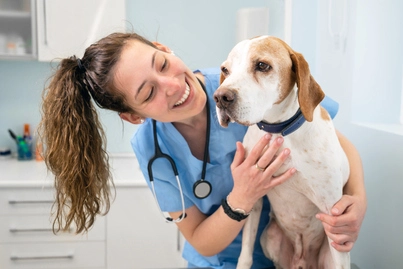Most of us have dealt with our own acne or skin issues at one point or another.
But have you ever had to contend with dog acne or dog blackheads on their belly?
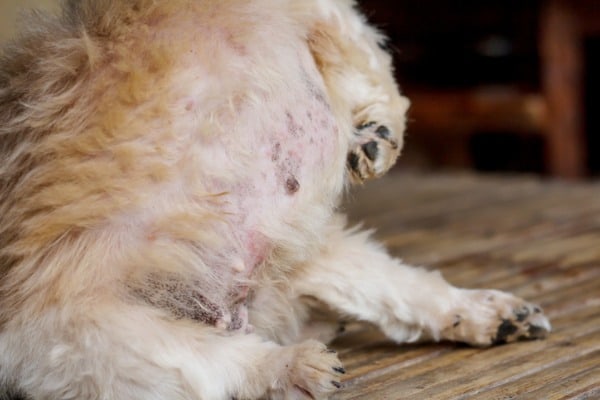
If you’re a dog parent, you might have encountered some spots or blackheads on your dog’s skin.
Or maybe you’ve found some black spots on your dog’s stomach, and you’re trying to figure out what they are.
It can happen:
It’s true that dogs can suffer from acne and skin conditions that we’re already familiar with – and might have battled ourselves at some point.
If the latter is the case, then you know how difficult it can be to treat.
We all want our pets to be in good health and that includes their skin.
While blackheads and dog acne aren’t usually a serious condition, they can be indicators of an underlying problem.
So treating your dog’s acne is less about making sure the other dogs in the park aren’t teasing them and more about ensuring everything is normal with their health.
There’s no need to panic.
We’ll say right away: it’s rarely a cause for concern, and dog acne and the accompanying conditions can be easily managed.
Connect with a verified veterinarian in minutes. No waiting for appointments or office hours. No high fees. Your pet's health made convenient and worry-free.
What Are the Signs of Dog Acne?

Since most of a dog’s body is covered in thick, sometimes dark hair, acne and blackheads might not be easily noticed.
You’re more likely to find blackheads or acne in areas where your dog has thinner hair, such as the insides of their ears, under their chin, and muzzle.
Most likely:
The soft skin on their tummy is where you’ll probably notice blackheads. In darker-skinned dogs, they might not be evident.
Blackheads can be a small spot, but if left untreated, they can grow larger. There can be one or several.
Sometimes, they’re so small that you might not be able to notice them by looking.
A belly rub could be your first clue that something’s up; blackheads can feel bumpy or hard.
If you’ve ever seen a blackhead on yourself, it’s easy to identify them on your dog, provided they’re not too dark, or there’s too much hair in the way.
But don’t try to slap a pore strip on them to solve the problem – more on that later.
Acne and pimples are commonly seen on the underside of the chin or around the lip area beneath the nose.
These can appear to be large, red bumps and are a little more difficult to diagnose at home.
Other causes?
There are several other causes for bumpy red skin around the mouth, so a vet is the best person to diagnose acne that presents itself as red bumps.
Dog blackheads and acne don’t typically bother your dog, but pimples can sometimes become inflamed, sore, or even infected.
Popping them might cause your dog pain and is best left to the vet if they decide an extraction is an option.
It’s the other conditions that come with acne and blackheads that might be some cause for concern – and might be making your dog uncomfortable.
No, Dog Acne Isn’t from Eating Too Much Pizza

The causes of acne in dogs aren’t the usual suspects when we think of breaking out.
Greasy foods, hormones, and stress won’t make your pup break out.
And similarly, nothing you buy at the pharmacy will be of much help.
So if a pore strip or a day at the spa won’t do anything for your pup, how do you get rid of unsightly blackheads and acne?
The first step you’ll need to take is to identify the underlying cause of your dog’s acne.
Even though the skin condition isn’t likely to cause your dog any discomfort, it can be a symptom of something else that should be addressed.
So, what could be causing acne in dogs?
Cushing’s Disease
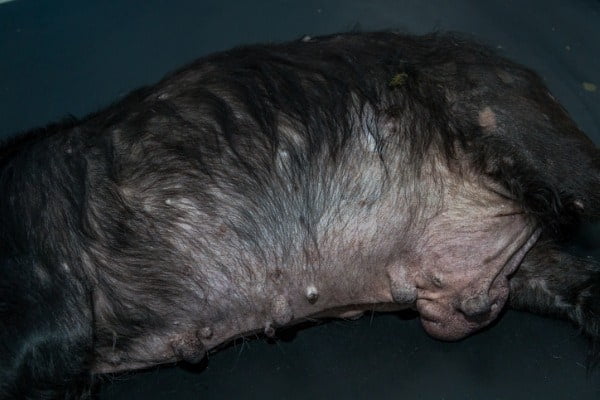
This is more likely to affect middle-aged or elderly dogs. It’s usually caused by a tumor on the pituitary gland.
One of the symptoms of Cushing’s Disease, or CD, is thinning skin.
This can lead to the appearance of blackheads, lesions, or calcium deposits on softer skin like the belly.
Many pet owners think the signs of CD are just a part of normal aging – lack of energy and weakness are among the typical symptoms.
But there are a few other things to look out for if your dog has blackheads on their belly.
First and foremost, consider their age, as dogs older than eight years old are more likely to develop the condition.
There are some breeds more prone to CD, such as poodles and dachshunds.
Increased thirst and urination, hair loss, and obesity are also signs to look out for.
So if those blackheads are one of the symptoms listed above, consult with your vet so they can properly test for the condition.
It can be expensive and time-consuming to treat, but it is something your dog can live comfortably with.
Demodex Mites
You might be more familiar with the phrase “mange,” which is the condition caused by Demodex mites.
Mange can be mild to severe, but most well-loved pets aren’t left to deteriorate to the point they’re losing hair all over.
However, you might notice some signs of mild mange in your well-loved pet.
Demodex mites already live on dogs, and there’s not much we can do about it.
It’s similar to the mites people have living in their eyelashes – sorry if that fun fact ruined your day.
Actually, a few of these Demodex mites can be beneficial to dogs and act like a probiotic.
They’re thought to be a vital part of your dog’s skin health, provided there’s no overgrowth of them.
Sometimes otherwise healthy dogs have a patch on their skin where the mites have multiplied. And they can also cause blackheads or scaly skin.
Most small mange spots are no cause for alarm and clear up on their own.
But if the spot spreads or shows no signs of improving, it could mean your dog is suffering from an autoimmune disorder.
Dogs that suffer from severe mange are often strays, malnourished, or anemic.
So if your healthy dog has multiple growing patches of mange, the vet will need to check for immunodeficiencies.
Mange can also be passed on to newborn puppies from their mother.
Since their immune systems aren’t fully developed, they could have an infestation of Demodex mites.
What to look out for?
Symptoms of mange include hair loss, scratching or licking the affected area, and red, scaly skin.
You might notice blackheads or pimple-like bumps on the belly or areas where the hair is naturally thin.
It’s fairly straightforward to treat mild to moderate mange in dogs. Shampoos and topical ointments usually do the trick.
Don’t tell your dog, but if you use topical medications, they might be inside for a few days in the cone of shame – licking those medications off of themselves could make them ill.
Seborrhea
This condition is responsible for things like greasy skin and dandruff in humans.
In dogs, it can cause the same issues. There are two different forms of seborrhea; one that causes dryness and one that causes an overproduction of oil.
Dogs can have one or a combination of both, but blackheads are likely to pop up if they’re dealing with oily skin.
The greasy substance that causes these skin disorders can build up and become irritating in areas like the armpits, ears, and belly. Your dog might be scratching a lot in these places.
If dryness is part of the issue, you’ll see flaky skin in their fur, just like dandruff that plagues people.
Retrievers, Basset Hounds, Spaniels, and German Shepherds are among the breeds more susceptible to the skin condition, although it can affect any dog.
If your pet’s coat seems overly greasy, they have blackheads or acne and seem to be itching certain areas frequently. They’re probably producing too much oil in their skin.
And sometimes, that overproduction of oil becomes a little smelly.
If your best friend is making you hold your nose every time you cuddle (and we don’t mean from gassiness), then that could be another indicator of seborrhea.
The smell can be mild to intense and sometimes has a faint fishy odor.
Getting it treated is good for clearing that acne and protecting them from secondary skin infections from bacteria or yeast, both of which thrive in that oily environment.
Medicated shampoos and keratolytic products usually do the trick, although be sure to stick with what your vet recommends.
A word of warning:
Some ingredients in your shampoo might work great for you but could harm your dog.
The fur baby might be in for some extra baths until this condition clears up – overbathing won’t help, but a regular bathing regimen should be on the schedule for a while.
Getting Rid of Dog Blackheads on Belly for Good
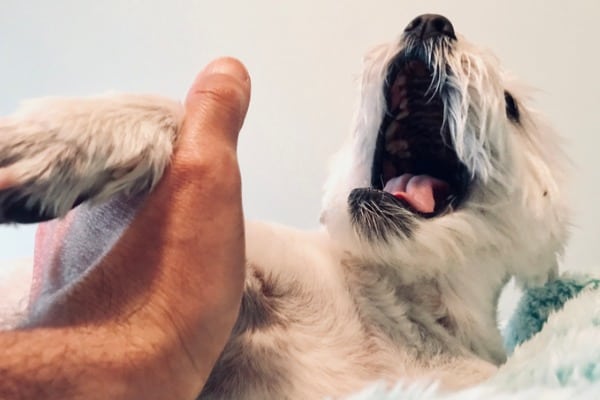
Dog blackhead removal isn’t as easy as extracting them as we do on our own skin.
As we’ve already said, the root cause has to be taken care of before you can expect their skin to clear up in the long term.
If you want to know how to get rid of dog blackheads, you’ll need to identify the cause – clogged pores and comedones in dogs are the symptoms of something else.
So going to town and popping them won’t do any good, and it’s not recommended by vets.
The spots will just come back, and you’re putting your dog at risk for secondary skin infections.
If you pop a pimple on your dog’s skin, you could also cause a sebaceous cyst.
They’re painful, they’re not pleasing to deal with, and they’re not worth popping any pimples in an attempt to clear up your dog’s skin.
So as tempting as it might be, don’t squeeze your dog’s spots.
Not only can you worsen the condition, but you’re not helping the underlying cause.
So is there anything you can do?
Once you and your vet have figured out why your dog is experiencing these breakouts, there are a few things you can try to kick the acne to the curb while your dog is receiving other treatments.
Some of the medications prescribed for the real reason behind your dog’s acne will help – the shampoo and ointments mentioned for seborrhea, for instance, will go a long way in helping clear up their skin.
In the meantime, your vet might suggest benzoyl peroxide washes (weaker than the kind people use, so don’t reach for that bottle on your sink just yet).
In severe cases, oral antibiotics could be prescribed to help get your dog’s skin back to normal.
In short – don’t squeeze.
Our own dermatologists preach those words to us, and the vet will do the same when it comes to your dog’s acne.
The vet will probably not attempt extraction unless your dog has a severely clogged pore. And in that case, best to leave it to the professionals.
Leave the Spots to Dalmatians
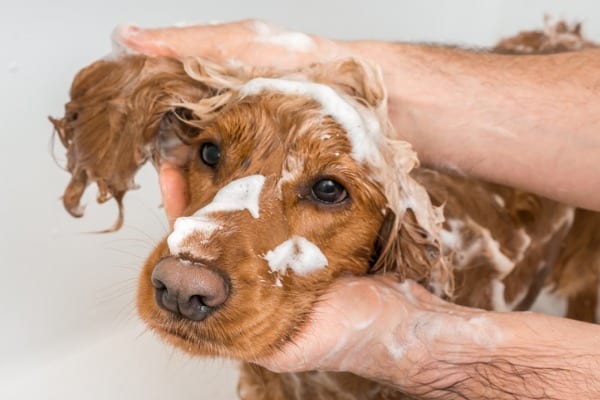
And every other lovely spotted breed out there.
Skin conditions on your dog can be as upsetting as if you were dealing with them on yourself.
But it’s essential to remember: they’re more often than not an indicator of something else.
But that doesn’t mean your pup is stuck with blackheads and acne forever, and they won’t have to simply grow out of it, like a lot of people do.
Any unusual skin ailment warrants a call to your trusted vet, who can help you figure out what is really to blame for your dog’s acne.
And while dog blackheads on a belly might be so tempting to squeeze, remind yourself that you could be making the situation worse.
Keep the pore extractors, harsh medications, and pore strips for yourself.
Even though you shouldn’t use your products on your dog, there are several options available for helping get your dog’s skin back in order.
The only catch? Many of these treatments will involve a B-A-T-H, possibly as often as once a week.
So you might want to have some extra towels handy and prepare for that post-bath shake that dogs love to share with us.

